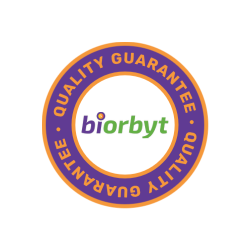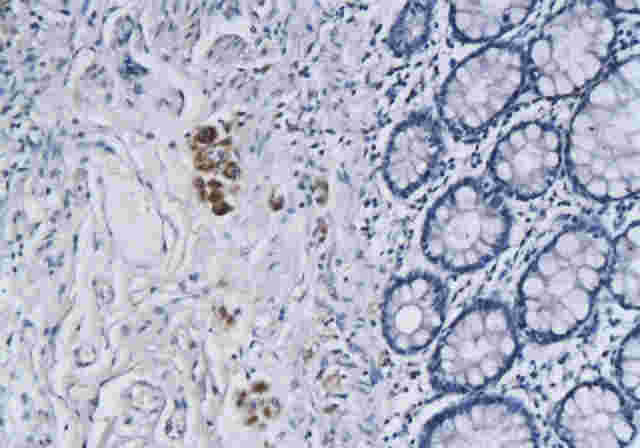You have no items in your shopping cart.
RET (phospho-Y1062) antibody
Catalog Number: orb304551
| Catalog Number | orb304551 |
|---|---|
| Category | Antibodies |
| Description | Rabbit polyclonal antibody to RET (phospho-Y1062) |
| Species/Host | Rabbit |
| Clonality | Polyclonal |
| Tested applications | IF, IH, WB |
| Reactivity | Human, Mouse, Primate, Rat |
| Immunogen | KLH-conjugated synthetic phosphopeptide corresponding to residues surrounding Y1062 of human RET protein. The exact sequence is proprietary. |
| Dilution range | WB: 1:500-1000, IHC-P: 1:100-200, IF/ICC: 1:100-500 |
| Form/Appearance | Liquid in 0.42% Potassium phosphate, 0.87% Sodium chloride, pH 7.3, 30% glycerol, and 0.01% sodium azide. |
| Conjugation | Unconjugated |
| Target | RET |
| Entrez | 24716, 5979, 19713 |
| UniProt ID | P35546, P07949, G3V9H8 |
| Source | Rabbit |
| Storage | Shipped at 4°C. Upon delivery aliquot and store at -20°C for one year. Avoid freeze/thaw cycles. |
| Buffer/Preservatives | Liquid in 0.42% Potassium phosphate, 0.87% Sodium chloride, pH 7.3, 30% glycerol, and 0.01% sodium azide. |
| Alternative names | anti CDHF12 antibody, anti CDHR16 antibody, anti P Read more... |
| Note | For research use only |
| Expiration Date | 12 months from date of receipt. |

Western blot analysis of RET (Phospho-Y1062) expression in HEK293T (A) whole cell lysates. (Predicted band size: 124 kD; Observed band size: 175 kD)
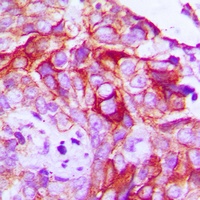
Immunohistochemical analysis of RET (Phospho-Y1062) staining in human breast cancer formalin fixed paraffin embedded tissue section. The section was pre-treated using heat mediated antigen retrieval with sodium citrate buffer (Phospho-H 6.0). The section was then incubated with the antibody at room temperature and detected using an HRP conjugated compact polymer system. DAB was used as the chromogen. The section was then counterstained with haematoxylin and mounted with DPX.
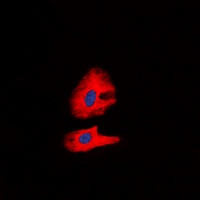
Immunofluorescent analysis of RET (Phospho-Y1062) staining in K562 cells. Formalin-fixed cells were permeabilized with 0.1% Triton X-100 in TBS for 5-10 minutes and blocked with 3% BSA-PBS for 30 minutes at room temperature. Cells were probed with the primary antibody in 3% BSA-PBS and incubated overnight at 4 °C in a hidified chamber. Cells were washed with PBST and incubated with a DyLight 594-conjugated secondary antibody (red) in PBS at room temperature in the dark. DAPI was used to stain the cell nuclei (blue).
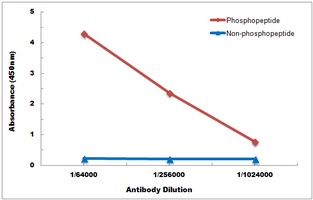
Direct ELISA antibody dose-response curve using Anti-RET (Phospho-Y1062) Antibody. Antigen (Phosphopeptide and non-phosphopeptide) concentration is 5 ug/ml. Goat Anti-Rabbit IgG (H&L) - HRP was used as the secondary antibody, and signal was developed by TMB substrate.
RET (Phospho-Y1062) antibody [orb571255]
ELISA, IHC, WB
Human, Mouse, Rat
Rabbit
Polyclonal
Unconjugated
50 μg, 100 μgRet (phospho-Tyr1062) antibody [orb5942]
ELISA, IF, IHC-Fr, IHC-P, WB
Bovine, Canine, Human, Mouse, Rabbit, Rat
100 μl, 200 μl, 50 μlRet (phospho-Y1062) antibody [orb644696]
IHC
Human, Mouse, Rat
Rabbit
Polyclonal
Unconjugated
200 μg, 100 μg, 50 μg, 25 μg
Filter by Rating
- 5 stars
- 4 stars
- 3 stars
- 2 stars
- 1 stars

